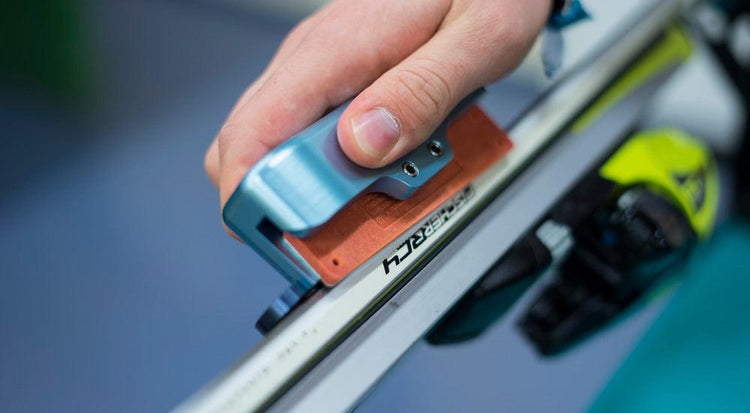
Filing the ski edge with the ski edge with the FG100 Pro by raze-cat and a diamond file
Opinions differ widely on how frequently you should sharpen your ski edges or snowboard edges. Some even leave at that they have their edges sharpened in a service workshop at the beginning of the season and, if necessary, a second time during the season. The main reason for this is that the service in a workshop can be costly, especially for families. In addition to that, it is not particularly practical to hand in your skis several times overnight in a workshop during your skiing holiday. This is especially difficult if you spend the night in a chalet in the middle of the skiing area and not down in the valley. Others, on the other hand, have the possibility to have the "workshop" with them with the appropriate tools (file or edge grinder) and to sharpen them whenever they want.
Frequency of the sharpening process
Sharpening the ski edges - how often?
How often you should sharpen your skis depends on many factors. The condition of the slope, for example, must be taken into consideration. Is there artificial snow on the slope and the slope is covered with ice? If so, then the edge of the ski wears off much faster than if you were on normal snow conditions or even on powder snow. In addition, of course, you have to sharpen the ski edges more often if you ski for several hours every day instead of just doing a few turns on the slope. By the way, the angle of the ski's side edge also influences its longevity. The more sharp the angle, the faster the edge becomes worn out when skiing. You can find out which angle of the edge is suitable for which type of ski in our blog post "How to tune skis | which ski edge angle suits you the best?". A general statement like grinding once or twice a week is therefore not possible.
The blunting of the edge
That's why you can also say that it is always advantageous to go on the slopes with freshly sharpened edges. This always enhances safety on the slope and ensures more fun.
Tip: skis and snowboards are not delivered with optimally sharp edges from the factory. This is not possible from a practical point of view. It is therefore advisable to test and sharpen the edges immediately after the purchase. This ensures optimum safety even on the first day.
A perfectly sharpened ski edge is no longer in optimal condition after the first ride. However, this does not mean that you have to take a file with you to go over the edge every time you stop for break. For a skiing day from about 9.00 am to 3.00 pm and normal slope conditions it would therefore be sufficient, to go over the edges every other day. But also here everything depends on the riding behaviour.
A feeling for the sharpness of the ski edge
As soon as you get a feeling for the sharpness of the edge, you can resharpen it as needed. The edge should be in optimal condition every day. Especially if you mainly plunge down the black slopes.
For safety reasons, it is therefore recommended that the edge is always sufficiently sharp. This is however not the case if you take the skis to the workshop only once or twice a season.
So grind your edges as often as possible. After a while you will get a feeling for how sharp the edge is and how sharp it should be while skiing. If you don't want to pay too much for the ski service in the long run, but still value an optimally sharp edge, it's worth buying tools to do the service yourself. Whether it's the file or the electric edge grinder, both devices offer you the possibility to regrind the ski anytime and anywhere.
SHOW ES 2000
